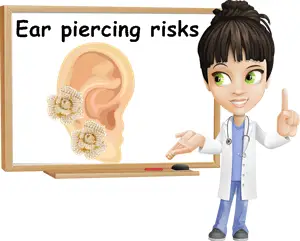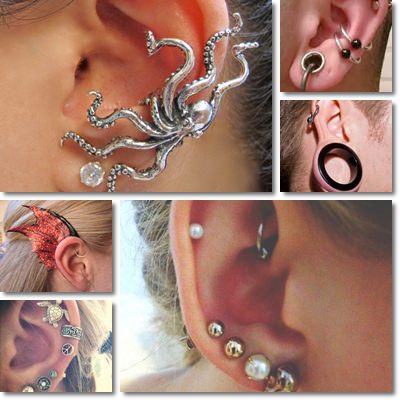Ear piercings have become increasingly popular lately and both girls and boys choose to have their ears as well as other body parts pierced as a sort of socio-cultural statement. While it may appear as a frivolous modern practice in the eyes of many God-fearing people, piercings and ear piercings in particular date back to prebiblical times. Even more surprising is the fact that men were the first to practice ear piercing, either for religious reasons or as a demonstration of their rank or social status.
Eventually, the practice was adopted by women as well. It was the association with women that lead to earlobe piercing being considered an effeminate practice, but, seeing that cultural concepts change over time and acquire other meanings and values, piercing one’s ears has become a sort of gender-neutral form of expression. But regardless of its rich cultural significance, ear piercing is not without risks and can lead to more or less serious complications.

Some people pierce their ears for fun. Others do it for fashion or to show their affiliation to a certain group. Many see it as a form of body embellishment and believe it increases their attractiveness. Whatever the reason for it, ear piercing is a strong trend in mainstream culture and the practice has evolved from the simple earlobe piercing to multiple piercings that allow for more intricate and original earring designs, suited to personal taste.
While a simple earlobe piercing does not generally hold any health risks, piercing more sensitive areas of the ear such as the top of the ear, the helix or the cartilage which take longer to heal and require greater care can result in higher risks of infection and subsequent complications.
Potential risks of ear piercings
The two main risks you face when getting your ears pierced are:
Infection
Getting your ears pierced either with a special instrument or with a simple needle puts you at risk of an infection. To avoid this, the piercing instrument has to be thoroughly disinfected, the specialist or friend piercing your ears should wash their hands well and wear sterile surgical gloves and, at the same time, disinfect the ear prior to the procedure to prevent bacteria already on the skin from infecting the freshly pierced area. Moreover, any earrings you plan on wearing while the piercing is still healing should be sterile and sterilized at regular intervals.
Even if the entire process goes well, remember that the ear can get infected after the procedure if you do not keep the area clean. Bacteria can easily reach the flesh wound and infect it more rapidly than normal. For this reason, it is recommended to avoid touching the ear, earring or pierced area with your hands without washing them first and use special skin care products. Also, some earrings are more likely to encourage an infection due to the material they are made of. Generally, silver earrings are recommended because the metal boasts antimicrobial properties.
Contracting a disease
Contracting both an infection and a disease from ear piercing may be rare, but it occurs nevertheless. There are many serious infectious diseases that can be contracted this way which is why it is important to take safety measures in this respect. First of all, choose a professional to pierce your ears. Ask for proof of sterilization and make sure any item that may go near your ear is individually packaged in a sterile wrapping. Also, ask the person piercing your ears to wear surgical gloves. There is no shame in wanting to be safe and a true professional will have no problems with meeting such safety norms.

Frequently asked questions
Is piercing your ear painful?
Of course it is. You are basically tearing a whole into a sensitive area of the body, so it is only natural it will hurt. But the pain will only last for a short while (a few seconds) and is bearable, so no need to take any pain medication. There may be a lingering sensation of discomfort in the days to follow while the piercing area heals. Unless there is an infection, you should barely notice it.
How long should you keep your earrings on so the piercing holes do not close?
Most professionals recommend wearing earrings for 2 to 6 months following the piercing procedure. The ears will heal, but not close up afterwards. Nevertheless, after 5 years of piercing my ears, I did not wear any earrings for almost a year and although they had long healed, my piercings started to close naturally.
So it really depends on the person, but it is important to wear earrings for a few weeks to a few months so the piercing heals without the ears closing. The older the piercings, the harder it will be for them to close. It can take up to 3 or 5 for older earring holes to heal and close if you no longer wear earrings. If the piercings are fresh, they may close up in a matter of hours and you might have to redo them. To prevent this, wear clean stud earrings, preferably made from silver or gold to prevent infections.
How long does it take for a ear piercing to heal?
As mentioned above, it varies from person to person. Whether or not you wear earrings, the piercing will heal in a matter of weeks, sometimes months. Not wearing earrings after a piercing usually leads to faster healing, while wearing them may take a little longer because the ear has to heal around the earring.
Do ear piercings leave a scar?
If you pierce your ears but then decide you don’t want to wear earrings, the ears should heal and the piercing close without leaving any mark. Even after wearing earrings for years, your ears can heal and close up without leaving a mark. Generally, wearing big, heavy earrings can open the piercing more and may leave either a small hole or a tiny mark after healing.
Ear piercings may become infected at any point. It does not really matter for how long you have them, but how you take care of them. Of course, fresh piercings have a higher risk of getting infected because the flesh is exposed.
The best earrings you can wear after piercing your earlobes are stud earrings made from either silver or gold. Silver, for example, is a good choice because it has antibacterial properties. Other metals can trigger allergic reactions or favor infections so make an informed decision about the kind of earrings your should wear before getting your ears pierced.
Symptoms of an Infection On Ear Piercing
Common symptoms of infected ear piercings include:
- Redness that does not go away.
- Swelling around the pierced area that persists.
- Yellow or green discharge coming from the pierced area.
- Bad smell at the perforation site.
- Tenderness lasting for more than several days.
- Persistent sharp or pulsating pain around the pierced area.
- Bleeding (normally, bleeding should last up to a few minutes).
- Fever, sweating or chills, which may indicate a more serious infection.
- A small white or red bump at the site of the piercing.
Different types of ear piercings may have a different evolution. Earlobe piercings, which are the most common, hurt the least, tend to have a low infection rate and heal faster. Piercings in the auricle of the ear, cartilage, helix, tragus or rook piercings are more painful and may take longer to heal because they involve the perforation of the cartilage of the ear.
Tips and solutions for ear piercing
If you fear an infection, it’s good to know a few tips and tricks on how to prevent it:
- First of all, wash your hands thoroughly before touching the ears or piercing.
- Clean your piercing with warm water and soap with a gentle formula.
- Disinfect the piercing with saline solution made from a teaspoon of non-iodized sea salt dissolved in a glass of distilled water. Apply the solution to the piercing using a cotton disc or a clean cloth.
- Disinfect earrings or ear cuffs regularly by emerging them in alcohol or hot water or by cleaning them with hot water and soap. This should be done after working out or performing any intense physical activity that may leave you sweaty.
If you suspect an infection, maintain the above-mentioned hygiene rules and refer to the piercing specialist that performed your ear piercing for further advice. He or she may recommend:
- Cleaning the area twice a day with warm water and soap, saline solution or special antiseptics.
- Taking ibuprofen or other pain relieving medication for pain.
- Applying cold compresses to reduce swelling.
- Taking out the earring to allow for the infection to clear better.
- Applying a local antibiotic according to your doctor’s recommendations.
- Seek medical help if you develop fever, cold sweats, nausea or other symptoms.
